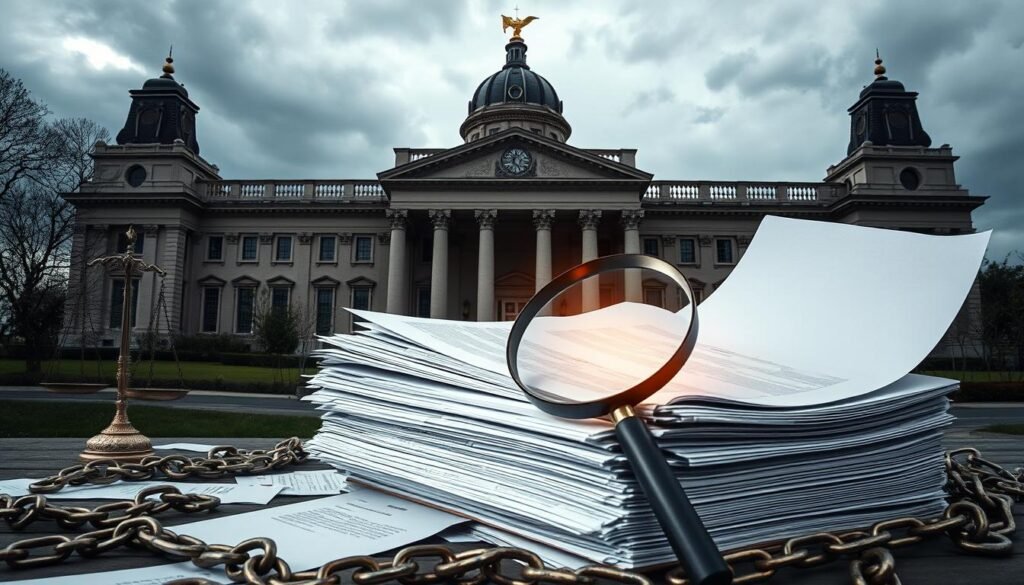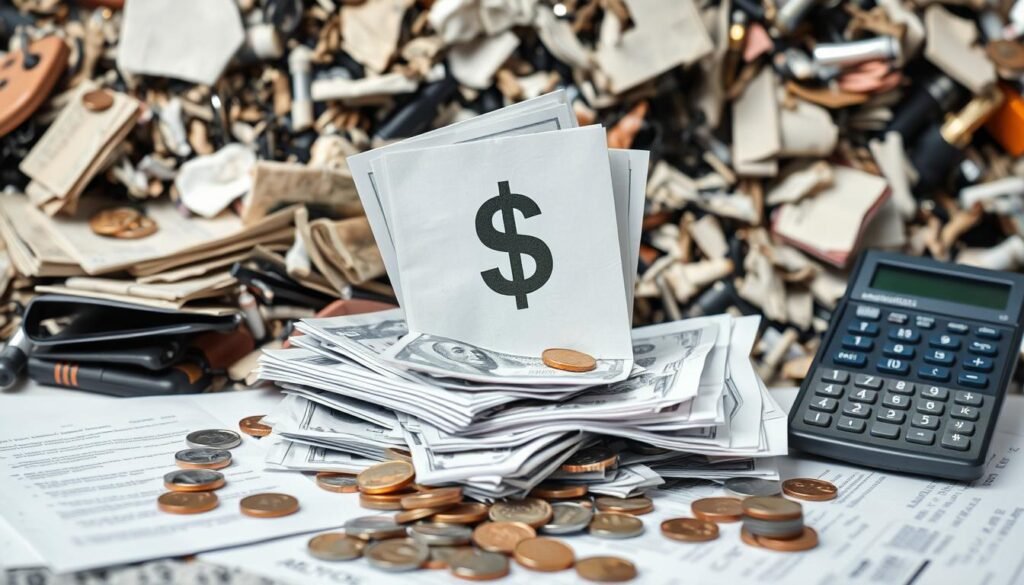In the last 7 years, big banks and insurance firms in Australia have sold 5.6 million useless “junk insurance” policies. That’s about 1 policy for every 4 adults. The 2018 Royal Commission found out that these companies made money by selling unnecessary add-ons with credit cards and loans. Sometimes, these premiums were over $2,000.
The Australian Securities and Investments Commission (ASIC) is keeping an eye on over $3.5 billion in refunds for these bad policies. This affects more than 3.6 million Aussies, or about 1 in 6 adults. Many people didn’t even know they had bought these junk policies. But now, they can get their money back.
Major Highlights
- Over 5.6 million “junk insurance” policies sold in Australia over the past 7 years
- Premiums for these useless policies can exceed $2,000 per person
- ASIC is overseeing $3.5 billion in remediations for 3.6 million impacted Australians
- Many consumers were unknowingly sold these junk policies
- You may be eligible for a full refund of premiums paid
Junk Insurance and Its Impact on Australian Consumers
Junk insurance is a big problem in Australia. It’s when policies don’t really cover anything. These policies are often sold with credit cards, loans, and other financial products.
Types of Worthless Insurance Policies
Some junk insurance includes Consumer Credit Insurance (CCI), Guaranteed Asset Protection (GAP), and Extended Warranty Insurance. These policies usually don’t cover much. They are often sold to people who don’t know what they’re getting into.
The Scale of the Insurance Mis-selling Problem
The problem of junk insurance in Australia is huge. In 2009, banks sold 662,000 CCI policies that were often useless. In the UK, over £50 billion has been given back to customers because of bad insurance deals.
How Banks Sold Unnecessary Insurance
Banks and financial companies have pushed these useless policies hard. They bundle them with credit products. This forces people to buy coverage they don’t need or understand, leading to a lot of mis-selling.
| Type of Junk Insurance | Coverage Overview | Common Issues |
|---|---|---|
| Consumer Credit Insurance (CCI) | Provides coverage for loan repayments in case of death, terminal illness, disability, or involuntary unemployment. | High premiums, limited coverage, often sold deceptively. |
| Guaranteed Asset Protection (GAP) | Covers the difference between the car’s market value and the outstanding loan balance in the event of a total loss. | Overlap with car insurance, often not needed. |
| Extended Warranty Insurance | Extends the manufacturer’s warranty on consumer goods, such as electronics and appliances. | Duplicates manufacturer’s warranty, high costs. |
The effect of junk insurance on Australians is big. It shows we need clearer rules and better protection in finance.
You may also like
The Royal Commission Findings on Insurance Misconduct
In 2018, the Banking Royal Commission in Australia uncovered a big problem with junk insurance. It found that many financial companies used unfair ways to sell unwanted insurance. They pushed these sales on people who didn’t need them.
Some insurers paid car dealers up to 79% of the first-year premium for selling these policies. This meant they paid out four times more in commissions than in claims to their customers.
“Over $160 million in remediation has been announced for consumers who were sold junk consumer credit insurance.”
The report showed that lenders and insurers have paid over $128 million to 312,000 people. This was for selling consumer credit insurance unfairly. Another $32 million will be paid to 122,000 people soon. This will make the total over $160 million for 434,000 Aussies.
These payments were for many reasons. This includes unfair sales, incorrect charges, and products that didn’t offer much value. For example, from 2011 to 2018, people got only 11 cents in claims for every dollar in premiums for CCI with credit cards. For all CCI products, it was just 19 cents for every dollar in premiums.
Because of the Royal Commission’s findings, regulators have taken steps. They banned unsolicited ‘cold call’ sales of CCI and direct life insurance. They also added a four-day sales period to give people time to review policies.

The junk insurance scandal and the efforts to fix it show how important consumer protection is. Millions of Australians are eligible for cash payouts from these refunds. The average claims process takes about 12 weeks after a claim is submitted.
How to Check if You’re Eligible for a Junk Insurance Refund
If you’re an Australian consumer, you might be owed a big refund. This is because of widespread insurance mis-selling. Financial institutions have to set aside $10 billion for refunds. To see if you’re eligible, look at your loan and credit card statements.
Common Signs of Mis-sold Insurance
- Regular insurance payments added to your loan or credit card accounts
- Policies with names like Consumer Credit Insurance (CCI), Guaranteed Asset Protection (GAP) Insurance, Extended Warranty Insurance, Mechanical Breakdown Insurance (MBI), Mortgage Protection Insurance, or Loan Protection Insurance
Where to Find Evidence in Your Documents
Look closely at your financial documents for signs of these insurance policies. If you’re not sure, ask your bank for old statements. You can also get help from claims specialists to spot mis-sold insurance.
Key Time Periods for Claims
There are specific times to make claims. If you had policies with Freedom Insurance between 2010 and 2018, you might be owed money. Some people have gotten refunds up to $90,000 for junk insurance.
“Aussies are owed billions of dollars in unclaimed junk insurance refunds. Millions of Australians are urged to check their eligibility for these refunds.”
By checking your financial documents and getting help if needed, you can find out if you’re owed a refund. The refunds can be huge, so it’s worth looking into and claiming what you deserve.
Consumer Credit Insurance (CCI): The Most Common Form of Junk Insurance
Consumer Credit Insurance (CCI) is a common “junk insurance” in Australia. It’s often sold with credit cards, personal loans, and mortgages. CCI helps if you can’t pay your loan due to job loss, sickness, or death.
But, ASIC says millions of Aussies bought CCI without knowing. Many couldn’t claim or wouldn’t benefit from it. The numbers are shocking:
- For CCI with credit cards, people got 11 cents in claims for every dollar in premiums.
- All CCI sold saw claims pay only 19 cents.
- 7 out of 8 lenders stopped selling CCI with credit cards. 5 out of 9 stopped with personal loans. 4 out of 9 stopped with home loans during ASIC’s review.
These figures show a big problem with CCI refund, credit card insurance claim, and loan protection refund mis-selling. People are now fighting to get their money back.

“Consumers should check if they already have insurance. Life or income protection insurance might cover sickness, injury, and death. Home, contents, or car insurance might cover items bought with credit that get damaged, lost, or stolen.”
Understanding GAP Insurance and Refund Eligibility
GAP insurance, or shortfall insurance, helps cover the gap between what your insurance pays and what you owe on your car loan. But, the Royal Commission found that it was often sold unfairly to Australians.
How GAP Insurance Was Mis-sold
GAP insurance is often not needed, thanks to good car insurance. Suncorp’s buy of MTAI in 2014 showed problems with selling add-on insurances like Equity Plus Insurance (EPI). This is another name for GAP insurance.
People didn’t know GAP insurance was added to their loans. Salespeople didn’t explain it well. This left many with a $10,000 gap after a write-off, even with GAP insurance.
Calculating Your Potencial Refund
- GAP insurance can cost about $1,000, and some paid too much for it.
- To figure out your refund, look at the premium, any interest, and how long you had the policy.
- ASIC has been worried about add-on insurance sales for two years. If you bought in the last 6 years, you might get a refund.
If you think you were misled about GAP insurance, check your policy. You might be due for a refund. It’s worth looking into.
Major Banks and Insurers Involved in Refund Schemes
In recent years, the Australian banking and insurance sectors have faced a reckoning. This is over the mis-selling of worthless or “junk” insurance policies. The bank insurance refund and insurer compensation schemes that have emerged have shown how widespread this problem is.
According to the Australian Securities and Investments Commission (ASIC), major insurers involved in refunding premiums include Aioi Nissay Dowa Insurance Company Australia, NM Insurance, Eric Insurance, LFI, Sovereign Insurance, Virginia Surety, QBE Insurance, MTA Insurance, Swann Insurance, Allianz Insurance, and National Warranty Company.
| Insurer | Refund Scheme Details |
|---|---|
| Swann Insurance (owned by IAG) | Sold approximately 846,000 policies through car and motorbike dealerships between 2008 and 2018, receiving about $1.07 billion in premiums but paying out only 10% in claims. In 2020, IAG settled a class action for $138 million on behalf of former Swann Insurance customers. |
| Commonwealth Bank | Involved in selling unnecessary and worthless Consumer Credit Insurance (CCI) products that generated $150 million annually within the bank. Former executives warned about the dangers of these CCI policies. |
| ANZ, Westpac | Facing ongoing class actions over CCI issues, with ASIC suing Westpac for allegedly signing up almost 400 customers to CCI without their consent. |
The scale of the bank insurance refund and insurer compensation problem in Australia is significant. ASIC has helped retrieve $160 million for customers affected by inappropriate insurance selling practices. The Consumer Action Law Centre’s “Demand a Refund” tool has facilitated $21 million in refunds for CCI and similar products.
The financial institution payback schemes are key in providing justice for Aussie consumers. They have been victims of this widespread mis-selling scandal. By holding the banks and insurers accountable, these refund programs aim to make amends and restore trust in the financial system.

“Less than 10 cents are paid out in claims for every dollar paid in premiums for consumer credit insurance (CCI), as opposed to car insurance paying out almost 89 cents per dollar.”
Step-by-Step Process to Claim Your Junk Insurance Refund
If you’ve been sold insurance you didn’t need, you might get a refund. Claiming your refund can seem hard, but it’s doable. Just follow these steps to get back what’s yours.
Required Documentation
First, collect all important documents. This includes loan contracts, credit card statements, and insurance policies. These will help prove your case for a refund. Having everything ready makes the process smoother and boosts your chances of success.
Submission Process
- Start by contacting the financial institution or insurer. Tell them you think you were sold unnecessary insurance and ask for a refund.
- Or, you can use a claims specialist like Koala Claims. They deal with the whole process for you. They often get better deals because of their connections.
- If you face problems, take your claim to the Australian Financial Complaints Authority (AFCA). They can review and solve your issue independently.
Expected Timeline
The time it takes to get your refund varies. But, many places have set aside money for these claims. Sometimes, you can get your refund quickly, in just a few weeks. But, be patient, as it can take months.
By claiming your refund, you’re not just looking out for yourself. You’re also helping to make sure insurers and lenders are fair. Stay alert, gather your proof, and take action to get the refund you’re owed.

Mechanical Breakdown Insurance and Extended Warranty Claims
In Australia, dealing with car insurance and extended warranties can be tricky. Mechanical Breakdown Insurance (MBI) and extended warranties often overlap with protections from Australian Consumer Law. This makes them seem unnecessary at times.
MBI is an extra you can add to your car insurance. The cost depends on your car, coverage, and policy term. There are two types: exclusionary and named-component. Exclusionary covers all parts except those listed, while named-component only covers specific parts.
Some insurers have been accused of mis-selling MBI and extended warranties. The Royal Commission into Banking Misconduct revealed how complex these policies are. Many consumers don’t understand them well, and claims ratios are often low.
If you bought an extended warranty or MBI policy, read the fine print. Claimo, a leading complaint management company, has helped many get refunds for junk insurance policies. They’re skilled in handling vehicle insurance claim issues too.
| Insurer | Refund Amount | Customers Impacted |
|---|---|---|
| Aioi Nissay Dowa Insurance Company Australia Pty Ltd (ADICA) | $7.2 million | 16,596 |
| Eric Insurance Limited | $3.37 million | 5,232 |
| Sovereign Insurance Australia Pty Ltd | $1.37 million | 1,858 |
| Virginia Surety Company, Inc. | $1.7 million | 4,026 |
| Liberty Finance’s insurer, LFI Group Pty Ltd | $951,700 | 2,001 |
| NM Insurance Pty Ltd and three insurers | $143,700 | 287 |
The insurance industry has changed a lot, with lower commissions and some insurers leaving. But, you can get refunds if you’re eligible. Claimo can help review your documents for any MBI refund, extended warranty compensation, or vehicle insurance claim issues.
Your Consumer Rights Under Australian Law
In Australia, you’re protected by the Australian Consumer Law (ACL). This law gives you automatic guarantees, even if sellers offer their own warranties. These guarantees often mean you don’t need extended warranties, as they cover the quality and safety of what you buy.
The Australian Securities and Investments Commission (ASIC) has made rules to make insurance sales clearer and fairer. These rules help ensure you get the right information about insurance policies. They also make sure you’re not sold something you don’t need or can’t use.
- The ACL protects you under the Trade Practices Act 1974. It gives you the right to repair, replace, get compensation, or a refund if sellers don’t meet their promises.
- Statutory rights don’t have a time limit. You might be able to get remedies even after warranties have expired.
- Businesses that break the ACL can face big fines. They can be fined up to $1.1 million, and individuals up to $220,000.
- The Australian Competition and Consumer Commission (ACCC) can look into complaints. They can take action against sellers for things like misleading conduct.
The ACL also includes implied conditions and warranties in contracts. This means goods must be of good quality and fit for their purpose. These warranties are key for consumer protection. They help even when financial services regulations don’t.
“Hundreds or thousands of dollars worth of insurance products such as motor vehicle warranties, consumer credit insurance, and gap insurance can be added to loans or credit cards, and consumers may be entitled to insurance claim rights if they were mis-sold these policies.”
If you think you’ve been sold insurance or warranties you didn’t need, you can complain. There are services available to help you use your consumer rights.
Working with Claims Specialists vs. DIY Refund Claims
Aussies have two ways to get refunds for worthless insurance policies. They can do it themselves or use professional claims services. DIY claims save on fees, but experts are key for tough cases or stubborn banks.
It’s estimated Aussies could get over $70 million in refunds each year for unwanted insurance and warranties. This issue has led to services like Claimo and Remediator. They work for free, taking a cut of the refund if they win.
| Service | Average Refund | Turnaround Time | Typical Fee |
|---|---|---|---|
| DIY Refund Claim | Varies | Varies | $0 |
| Claims Specialist (e.g. Remediator) | $2,179 | 38 days | 30% of refund |
Class actions can bring big refunds quickly, but they have downsides. They can start without everyone’s consent. This means high legal and funding fees, up to 40% of the refund.
Choosing between DIY and professional help for junk insurance refunds depends on your situation. The right choice varies by case complexity and personal preference.
“Australians could be due for over $70 million worth of refunds each year for insurance and warranty products they may not know they purchased.”
Free Ombudsman schemes help Aussies get refunds for bad insurance. Community legal centers and financial counselors also use DemandARefund.com. They help those who unknowingly bought junk insurance.
Success Stories and Average Refund Amounts in Australia
Millions of Aussies have been affected by junk insurance. But, there are success stories of people getting refunds. A Queensland resident got $4,280 back for a mis-sold car loan insurance. Claimo has helped over 1,600 Australians get back more than $5 million in premiums.
The amount of refund varies by insurance type and how long it was held. For car loan insurance, long-term holders have gotten refunds over $6,000. Loan protection insurance refunds average around $1,400 per person. ASIC estimates that $3.55 billion in refunds are possible across Australia.
Despite the big problem, many have successfully claimed refunds. Firms like Get My Refund have returned $4.3 million. The Consumer Action Law Centre’s tool has helped seek $31 million in refunds. New federal reforms aim to stop junk insurance sales, helping Aussies get their money back.
